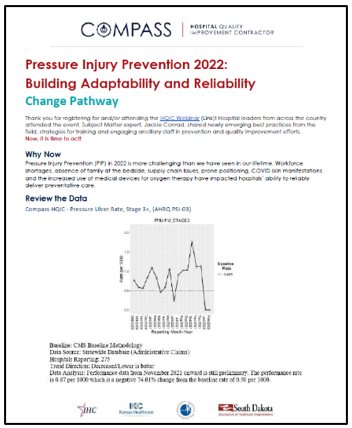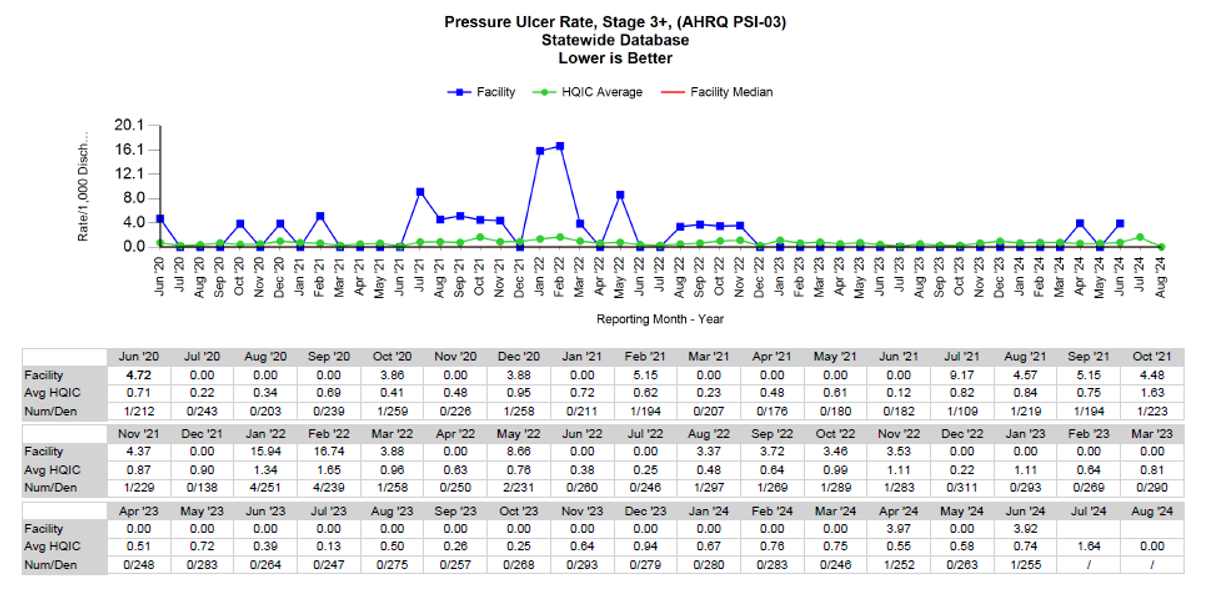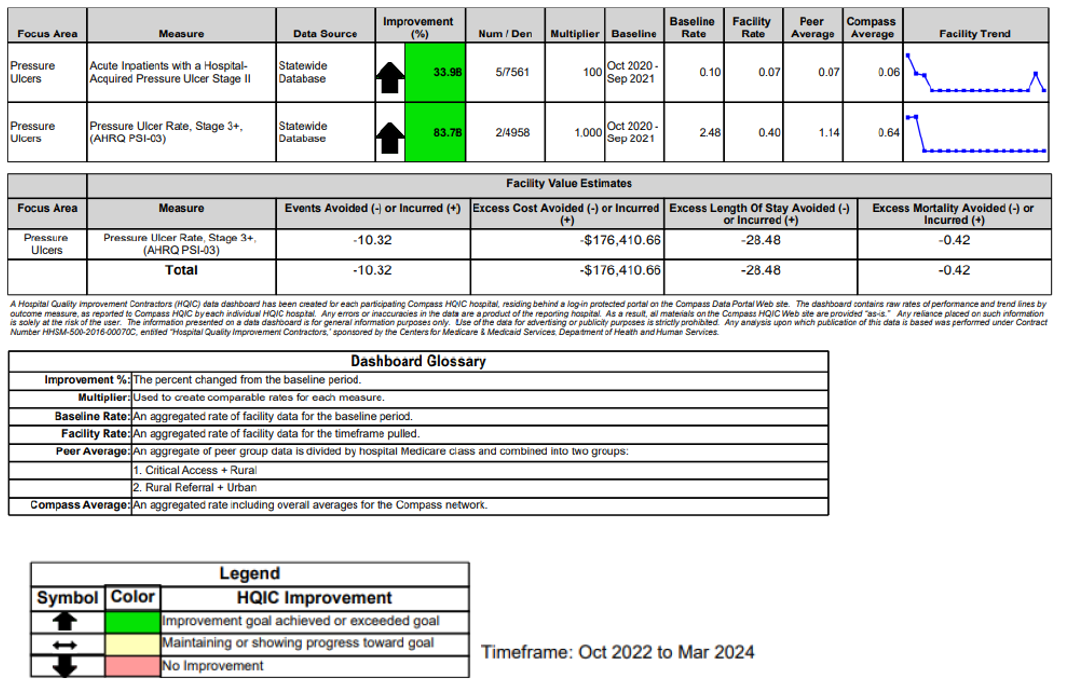An acute care hospital in Kansas partnered with the Compass HQIC, led by the Iowa Healthcare Collaborative (IHC), a Centers for Medicare & Medicaid Services (CMS) Hospital Quality Improvement Contractor (HQIC), and in partnership with the Kansas Healthcare Collaborative (KHC) to effectively reduce its pressure ulcer rates. Together, the Compass HQIC team and the hospital identified key factors contributing to pressure injuries among their Medicare patients. As a result of their partnership with the Compass HQIC, the hospital achieved a 77.28 percent reduction in pressure ulcer rates from March 1, 2022, to April 30, 2024.
The hospital wanted to reduce pressure injuries and noticed their rates were increasing. However, due to frequent leadership and quality department staff changes, they had not been able to give full attention to this effort. While they understo od its importance, they had not yet conducted a root cause analysis to determine the cause of their rising pressure injury rates.
od its importance, they had not yet conducted a root cause analysis to determine the cause of their rising pressure injury rates.
The Compass HQIC provided the hospital with resources for conducting a Root Cause Analysis (RCA), including Guidance for Performing RCA with Performance Improvement Projects and 5 Whys: Finding the Root Cause. Additionally, the Compass HQIC provided a Pressure Injury Prevention Change Pathway that shares emerging best practices from the field for training and engaging ancillary staff in pressure injury prevention. To further support the RCA process, the hospital also received a Pressure Ulcer Rate run chart along with patient level detail to assist the hospital in a second review to understand if present on admission was captured correctly and discover any opportunities for improvement in documentation and coding. An example of a Pressure Ulcer Rate Run Chart is shown in Figure 1 below.
Figure 1. Pressure Ulcer Rate Run Chart (Stage 3+)
The hospital requested two annual onsite visits from KHC, during which HQIC quality measures, current projects, and data were reviewed. KHC consultants helped the hospital create an annual quality improvement workplan, which incorporates Specific, Measurable, Achievable, Relevant, Timely, Inclusive and Equitable (SMARTIE) goals. This process ensures the workplan aligns with the hospital’s strategic priorities, allowing IHC to provide more effective support and foster stronger engagement with the hospital.
Interventions identified to Decrease Pressure Ulcer Injury
The RCA revealed three key issues: 1) Patients with pressure ulcers present on admission were not documented by a physician; 2) Insufficient patient and family education on pressure ulcers and their prevention; and 3) A lack of collaboration between the hospital's quality and wound care teams.
With the help of the Compass HQIC, the hospital reduced pressure injuries by implementing the following interventions.
Increased Provider Documentation for Patients with Pressure Ulcers
To help the hospital improve its documentation of patients with pressure ulcers on admission, IHC provided the hospital with a Pressure Ulcer Rate Run Chart (see Figure 1), enabling clinical staff to examine patient charts, verify if pressure ulcers were present upon admission and identify a physician's signature to confirm this information. The hospital also provided education to all physicians, nursing and coding staff that readily access patient charts to ensure they know to notify a physician if a signature is needed to confirm pressure ulcers are present at admission.
Provided Patient and Family Education 
The Compass HQIC and the hospital identified a gap in education for high-risk patients and responded by providing pressure injury education to patients and their families. KHC supplied the hospital with the Preventing Pressure Injuries: An Invitation to Partner in Prevention fact sheet from Convergence Health Consulting. This resource details the reasons behind patients' high risk for pressure injuries and offers practical guidance on preventive measures for both patients and their families.
Improved Teamwork Between Quality and Wound Care Teams
The hospital had established quality and wound care teams that were not collaborating effectively. The Compass HQIC emphasized the importance of teamwork and encouraged these teams to unite in addressing quality and patient safety. KHC provided the hospital with the Preventing Hospital Acquired Pressure Injuries (HAPI) Change Package from Cynosure Health. The change package features a spreadsheet that outlines pressure injury prevention tasks and assigns responsibilities to various members of the care team, including nursing staff, aides, administrative personnel, respiratory therapists, food service workers, as well as patients and their families.
Hospital Dashboard Report
Implementing best practices not only improves the quality of care for Medicare patients but also results in cost savings for the hospital. IHC provides the hospital with a dashboard report, from the HQIC data portal, detailing advancements in pressure ulcer measures and associated cost savings. This report is presented to the hospital board members during board meetings to illustrate cost savings through pressure injury interventions. Figure 2 below shows an example of a dashboard report.
Figure 2. Hospital Dashboard Report
 Keys to Success
Keys to Success
The success of the Compass HQIC can be replicated by following these steps:
- Provide hospitals with resources for pressure injury prevention to improve the management and prevention of pressure injuries in Medicare patients.
- Enhance hospital engagement by developing an annual workplan that uses SMARTIE goals to align HQIC and hospital quality improvement objectives.
- Help hospitals understand their pressure ulcer measurement data to drive impactful change.
For more information, visit IHConline.org.
This material was prepared by The Bizzell Group (Bizzell), the Data Validation and Administrative (DVA) contractor, under contract with the Centers for Medicare & Medicaid Services (CMS), an agency of the U.S. Department of Health and Human Services (HHS). Views expressed in this material do not necessarily reflect the official views or policy of CMS or HHS, and any reference to a specific product or entity herein does not constitute endorsement of that product or entity by CMS or HHS. 12SOW/Bizzell/DVA-1445-09/04/24

